ASUS UL80Vt First Look: Mobility Redefined
by Jarred Walton on October 24, 2009 8:00 PM EST- Posted in
- Laptops
ASUS UL80Vt Benchmarked - Battery and LCD
Finally, we have perhaps the most interesting aspect of the UL80Vt. Decent performance and a reasonable size are nice, but there are plenty of laptops to offer those amenities. What truly sets the UL80Vt apart from most other Windows-based laptops is the battery life. ASUS claims "up to 12 hours", and we decided to check their claim.
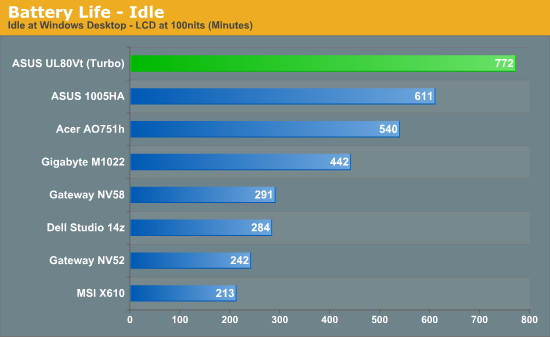
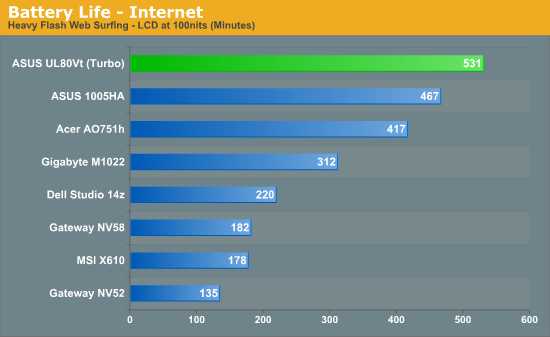
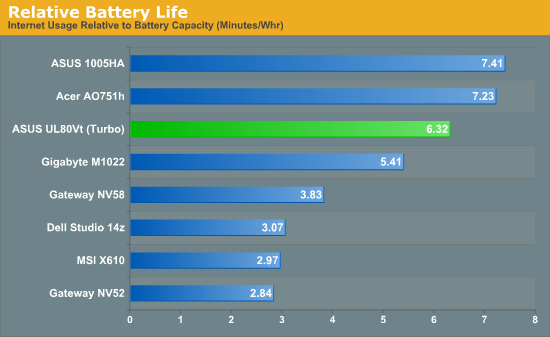
Idle battery life reached nearly 13 hours… and that's what Turbo mode (overclocking) enabled. Granted, the system was sitting idle -- hardly a realistic usage scenario for most users. However, light office use isn't going to be much more taxing than our idle battery life test, and if you decide to disable Turbo mode battery life can only improve. In the far more pertinent Internet battery life, ASUS still achieves record-setting performance. Our initial test (we haven't had time for multiple test runs) came just shy of nine hours of continuous Web surfing. That's with several flash ads on be active website page, which again should be a bit more taxing than what many users view.
Looking at battery capacity and relative battery life, we finally have a true laptop that can actually trade blows with Apple's MacBook line. We never have been able to determine exactly what Apple does in order to achieve their high battery life, but clearly part of it has to be using lower voltage CPUs. ASUS follow suit by using the Core 2 Duo SU7300, which actually surpasses Apple by going with a 10W TDP CPU. Apple currently uses the 25W TDP SP9300, while some previous models used the 17W Core 2 Duo SL9000 series.
Even overclocked the SU7300 practically sips power in comparison to many other CPUs. We measured average power use of 9.5W for the UL80Vt in our internet test compared to 21.1W for the Gateway NV52 and 15.6W for the Gateway NV58. 10.1" and 11.6" netbooks only get down to 8.0-8.5W in the same test, and performance is obviously substantially higher with Core 2 Duo. What's truly impressive is that laptops like the UL80Vt previously sold for nearly $2000 -- sometimes more. With the boom in netbooks sales, manufacturers have apparently realized there's a real market for smaller laptops that get extremely good battery life.
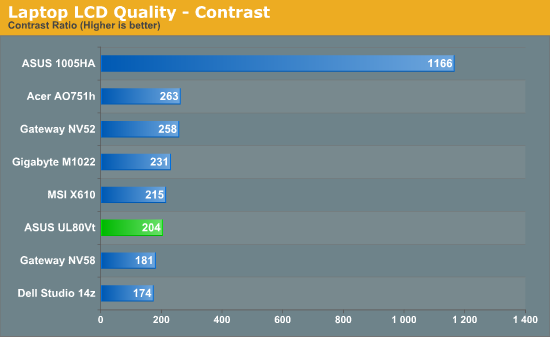
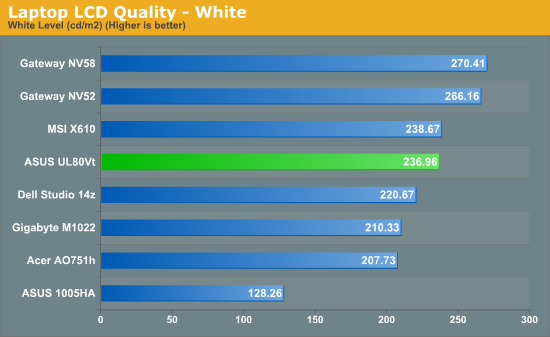
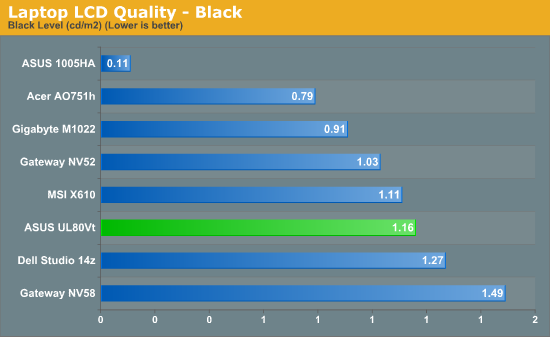
About the only fly in the ointment with the UL80Vt is the LCD panel. Here you can see our contrast ratio test results, and the results are down in the dumps with many other laptops. Sometimes I feel like a lone voice crying in the wilderness telling manufacturers that laptop LCD quality is a serious concern. I know from responses to previous articles that many of you agree, but unfortunately it's something that's difficult to quantify because many reviews don't ever look at LCD quality with quantitative results. ASUS has used very nice LCD panels on lesser offerings (i.e. the Eee 1005HA has an excellent LCD), and we have seen decent displays on other laptops and notebooks as well. If the system cost $25-$50 more but it had a 1000:1 contrast ratio (with an LCD that could still run at 250 nits), I wouldn't hesitate to give the UL80Vt an unequivocal recommendation. As it stands, it's a great laptop but it isn't quite perfect.










100 Comments
View All Comments
MrSpadge - Sunday, October 25, 2009 - link
technique = technology *doh*Alexo - Monday, June 28, 2010 - link
Let me add my vote for:- a matte display
- a good display (*VA or IPS)
- a quality keyboard
I am willing to pay for these features and I am sure others will as well.
tmgp - Sunday, October 25, 2009 - link
"We looked at the ASUS UL50Vt running on Windows 7 Home Basic"Does windows 7 home basic exists?... Don't think so
iamezza - Sunday, October 25, 2009 - link
Windows 7 Home BasicWindows 7 Home Basic will be available in emerging markets such as Bangladesh, Brazil, People's Republic of China, India, Indonesia, Italy, Mexico, Pakistan, the Philippines, and Thailand.[13] It will not be available in countries such as Australia, Canada, France, Germany, Ireland, The Netherlands, United Arab Emirates, Saudi Arabia, New Zealand, the United States, and the United Kingdom.[13] Some Aero options are excluded along with several new features.
MadMan007 - Sunday, October 25, 2009 - link
Why is it called the UL80Vt? If that were consistent with the others in the line it would imply an 18" screen. Wierd..strikeback03 - Monday, October 26, 2009 - link
I though the same thing, did they already use UL40Vt on something?codedivine - Sunday, October 25, 2009 - link
I request benchmarks for new Turion II based laptops. Turion II is 45nm based with Phenom based cores. The Athlon QL-64 used here is 65nm bsed and uses K8 cores.I also request benchmarks for the machine HP dm3. It comes in an AMD flavor and a Intel flavor and in the Intel flavor supposedly provides 10 hours of battery life and on AMD about 5.5.
codedivine - Sunday, October 25, 2009 - link
Also, I specifically request Turion II and NOT Athlon II. Athlon II supposedly only have 64b FP units as opposed to full speed 128b FP on Turion II.feelingshorter - Sunday, October 25, 2009 - link
Can we get battery numbers without turbo mode enabled? I don't see why anyone would turn turbo on unless they know they are doing something specifically CPU intensive. Could you please add that to the chart?JarredWalton - Sunday, October 25, 2009 - link
The whole reason for the "first look" is that battery tests are going at a rate of about one per day. It's the blessing and curse of a long battery life, and I like to be thorough. In the full review, I'll provide some figures for with and without Turbo, as well as battery life with the G210M enabled (with and without Turbo if I've got the time...).From what I can see, the Turbo really only accounts for about a 0.5W-1W increase in power draw, so without Turbo battery life might increase to around 560 minutes for Internet surfing, or best-case about 590 minutes. I think idle power draw isn't affected as much (closer to .25W-.5W increase), so without Turbo idle battery life would be in the realm of 800-840 minutes. Obviously, that's still a HECK of a long time. :) I'll get you numbers in about a week or so when I've finished testing.